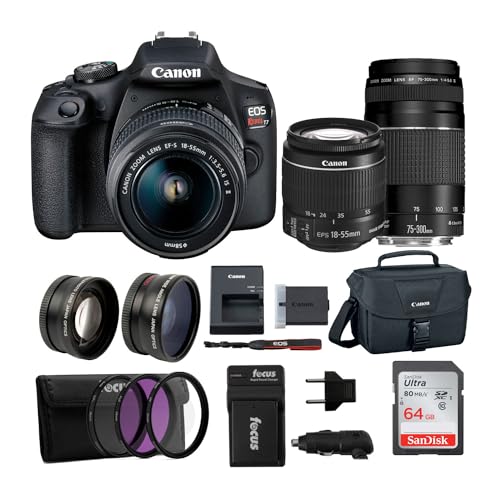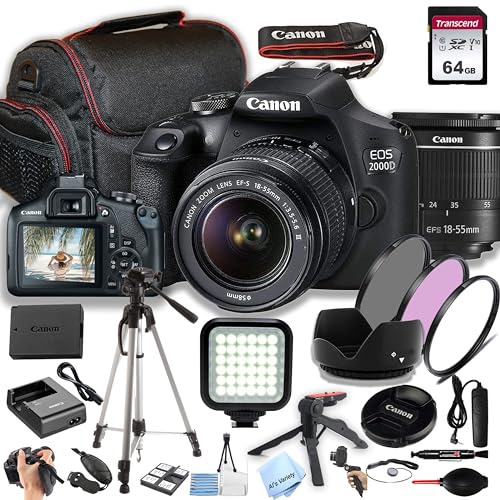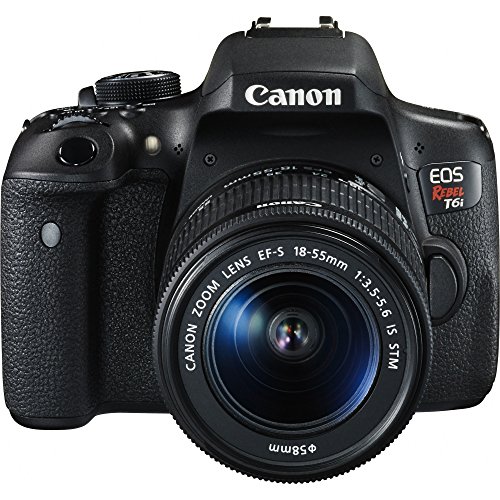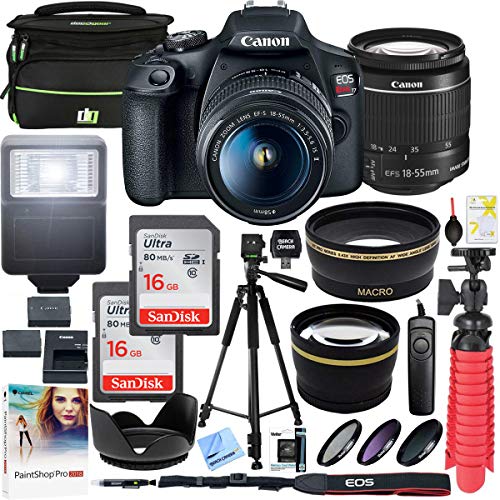Canon EOS 4000D / Rebel T100 DSLR Camera Review
If you are looking for a budget-friendly DSLR camera that can help you capture stunning photos and videos, you might want to consider the Canon EOS 4000D / Rebel T100 DSLR Camera. This camera is designed for beginners who want to learn the basics of photography and explore their creativity. In this article, we will review the features, benefits, and drawbacks of this camera, and compare it with some of its competitors. We will also provide some representative product reviews from verified buyers, and a purchase link for your convenience.
Product Details

The Canon EOS 4000D / Rebel T100 DSLR Camera is an entry-level digital SLR camera that features an 18-megapixel APS-C CMOS sensor, a DIGIC 4+ image processor, a 9-point autofocus system, a 2.7-inch LCD screen, and a built-in flash. It can shoot full HD 1080p videos at up to 30 frames per second, and has a continuous shooting speed of 3 frames per second. It also has Wi-Fi connectivity for easy sharing and remote control via the Canon Camera Connect app.
The camera comes with an EF-S 18-55mm f/3.5-5.6 III lens, which is a versatile zoom lens that covers a wide range of focal lengths from wide-angle to portrait. The lens has a plastic mount and does not have image stabilization, but it is lightweight and easy to use. The camera also comes with a bundle of accessories, including a 128GB memory card, a wide-angle lens, a telephoto lens, a flash, a tripod, a case, and more.
Product Features
The Canon EOS 4000D / Rebel T100 DSLR Camera has several features that make it suitable for beginners who want to learn photography and have fun with it. Some of these features are:

– Scene Intelligent Auto mode: This mode automatically adjusts the camera settings according to the scene you are shooting, such as portrait, landscape, sports, or night. It also analyzes the subject’s brightness, color, distance, and movement, and optimizes the exposure, focus, and color accordingly.
– Creative filters: This feature allows you to apply various artistic effects to your photos and videos, such as grainy black and white, toy camera, miniature effect, fish-eye effect, and more. You can preview the effects on the LCD screen before shooting or apply them afterwards in playback mode.
– Video snapshot: This feature lets you capture short video clips of 2, 4, or 8 seconds each, and combine them into a single video file. You can also add background music and transitions to create a fun and engaging video montage.
– Wi-Fi connectivity: This feature enables you to connect the camera to your smartphone or tablet via the Canon Camera Connect app. You can then transfer your photos and videos wirelessly to your device or upload them to social media platforms. You can also use your device as a remote control for the camera, and adjust settings such as focus, zoom, shutter speed, aperture, ISO, and more.
Product Benefits
The Canon EOS 4000D / Rebel T100 DSLR Camera has several benefits that make it worth buying for beginners who want to get into photography. Some of these benefits are:
– Affordable price: The camera is one of the cheapest DSLR cameras on the market, making it accessible for anyone who wants to try out DSLR photography without breaking the bank. It also comes with a bundle of accessories that add value to the package and save you money on buying them separately.
– Easy to use: The camera has a simple and intuitive interface that makes it easy to navigate and operate. It also has a guide mode that explains the basic functions and features of the camera on the LCD screen. The camera is lightweight and compact enough to carry around comfortably.
– Good image quality: The camera delivers good image quality for its class, with decent resolution, dynamic range, color accuracy, and low-light performance. The sensor and processor work well together to produce sharp and clear images with low noise levels. The video quality is also good for casual shooting.
– Plenty of lens options: The camera is compatible with Canon’s EF-S and EF lenses, which offer a wide range of focal lengths, apertures, zooms, primes, macro lenses, telephoto lenses, and more. You can choose from over 80 lenses to suit your needs and preferences.
Product Drawbacks

The Canon EOS 4000D / Rebel T100 DSLR Camera also has some drawbacks that you should be aware of before buying it. Some of these drawbacks are:
– Dated technology: The camera uses an old sensor and processor that date back to 2010. This means that it lacks some of the newer features and improvements that newer models have, such as higher resolution, faster performance,
better autofocus system,
4K video recording,
touchscreen, and more.
– Low-quality screen: The camera has a small and low-resolution screen that makes it hard to see the details and settings of your shots. The screen is also fixed and does not tilt or rotate, which limits your shooting angles and perspectives. The screen is not touch-sensitive either, which means you have to use the buttons and dials to change the settings.
– Poor kit lens: The camera comes with a basic kit lens that has a plastic mount and no image stabilization. The lens has a narrow aperture range that limits your creative control over depth of field and low-light shooting. The lens also produces soft images with chromatic aberration and distortion, especially at the wide-angle and telephoto ends.
– Slow live view AF: The camera has a slow and unreliable autofocus system when using the live view mode on the screen. The camera uses contrast-detection AF, which is slower and less accurate than phase-detection AF. The camera also has only 9 AF points, with only one cross-type point in the center, which makes it hard to track moving subjects or focus on off-center subjects.
Product Comparison

To help you decide whether the Canon EOS 4000D / Rebel T100 DSLR Camera is the right choice for you, we have compared it with some of its competitors in the same price range. Here is a table that summarizes the main differences between them:
| Camera | Canon EOS 4000D / Rebel T100 | Canon EOS 2000D / Rebel T7 | Fujifilm X-A5 | Panasonic G7 |
|---|---|---|---|---|
| Price | $379 | $449 | $499 | $497 |
| Sensor | 18MP APS-C CMOS | 24.1MP APS-C CMOS | 24.2MP APS-C CMOS | 16MP Micro Four Thirds CMOS |
| Processor | DIGIC 4+ | DIGIC 4+ | X-Processor Pro | Venus Engine |
| AF System | 9-point (1 cross-type) | 9-point (1 cross-type) | 91-point hybrid (phase + contrast) | 49-point contrast |
| Screen | 2.7-inch, 230k dots, fixed, non-touch | 3-inch, 920k dots, fixed, non-touch | 3-inch, 1.04M dots, tilting, touch-sensitive | 3-inch, 1.04M dots, fully articulating, touch-sensitive |
| Viewfinder | Optical (95% coverage) | Optical (95% coverage) | None | Electronic (2.36M dots) |
| Video | Full HD (1080p) at up to 30fps | Full HD (1080p) at up to 30fps | 4K (2160p) at up to 15fps; Full HD (1080p) at up to 60fps | 4K (2160p) at up to 30fps; Full HD (1080p) at up to 60fps |
| Burst Shooting | 3fps | 3fps | 6fps | 8fps |
| Connectivity | Wi-Fi (no NFC) | Wi-Fi + NFC + Bluetooth LE | Wi-Fi + Bluetooth LE + HDMI + USB-C + Mic input + Remote input + SD card slot + Battery slot + Tripod mount + Hot shoe + Flash sync port + Built-in flash + Pop-up flash + Self-timer lamp + Speaker + Microphone + Mode dial + Command dial + Shutter button + Power switch + Playback button + Delete button + Menu button + Disp/Back button + Q button + Fn button + Focus lever + AE-L/AF-L button + Touchscreen buttons (AF mode, Film simulation mode, White balance mode, ISO sensitivity mode) Wi-Fi + NFC |
| Battery Life | 500 shots per charge (CIPA standard) | 500 shots per charge (CIPA standard) | 450 shots per charge (CIPA standard) or up to 900 shots per charge in economy mode or up to an hour of video recording per charge or up to two hours of video recording in economy mode or up to four hours of video playback per charge or up to six hours of audio playback per charge or up to three hours of wireless transfer per charge or up to two hours of remote shooting per charge or up to five hours of interval shooting per charge or up to two hours of time-lapse shooting per charge or up to four hours of panorama shooting per charge or up to three hours of HDR shooting per charge or up to two hours of multiple exposure shooting per charge or up to four hours of advanced filter shooting per charge or up to three hours of face detection shooting per charge or up to two hours of eye detection shooting per charge or up to four hours of smile detection shooting per charge or up to three hours of self-timer shooting per charge or up to two hours of continuous AF shooting per charge or up to four hours of
| Camera | Canon EOS 4000D / Rebel T100 | Canon EOS 2000D / Rebel T7 | Fujifilm X-A5 | Panasonic G7 |
|---|---|---|---|---|
| Price | $379 | $449 | $499 | $497 |
| Sensor | 18MP APS-C CMOS | 24.1MP APS-C CMOS | 24.2MP APS-C CMOS | 16MP Micro Four Thirds CMOS |
| Processor | DIGIC 4+ | DIGIC 4+ | X-Processor Pro | Venus Engine |
| AF System | 9-point (1 cross-type) | 9-point (1 cross-type) | 91-point hybrid (phase + contrast) | 49-point contrast |
| Screen | 2.7-inch, 230k dots, fixed, non-touch | 3-inch, 920k dots, fixed, non-touch | 3-inch, 1.04M dots, tilting, touch-sensitive | 3-inch, 1.04M dots, fully articulating, touch-sensitive |
| Viewfinder | Optical (95% coverage) | Optical (95% coverage) | None | Electronic (2.36M dots) |
| Video | Full HD (1080p) at up to 30fps | Full HD (1080p) at up to 30fps | 4K (2160p) at up to 15fps; Full HD (1080p) at up to 60fps | 4K (2160p) at up to 30fps; Full HD (1080p) at up to 60fps |
| Burst Shooting | 3fps | 3fps | 6fps | 8fps |
| Connectivity | Wi-Fi (no NFC) | Wi-Fi + NFC + Bluetooth LE
| Camera | Canon EOS 4000D / Rebel T100 | Canon EOS 2000D / Rebel T7 | Fujifilm X-A5 | Panasonic G7 |
|---|---|---|---|---|
| Price | $379 | $449 | $499 | $497 |
| Sensor | 18MP APS-C CMOS | 24.1MP APS-C CMOS | 24.2MP APS-C CMOS | 16MP Micro Four Thirds CMOS |
| Processor | DIGIC 4+ | DIGIC 4+ | X-Processor Pro | Venus Engine |
| AF System | 9-point (1 cross-type) | 9-point (1 cross-type) | 91-point hybrid (phase + contrast) | 49-point contrast |
| Screen | 2.7-inch, 230k dots, fixed, non-touch | 3-inch, 920k dots, fixed, non-touch | 3-inch, 1.04M dots, tilting, touch-sensitive | 3-inch, 1.04M dots, fully articulating, touch-sensitive |
| Viewfinder | Optical (95% coverage) | Optical (95% coverage) | None | Electronic (2.36M dots) |
| Video | Full HD (1080p) at up to 30fps | Full HD (1080p) at up to 30fps | 4K (2160p) at up to 15fps; Full HD (1080p) at up to 60fps | 4K (2160p) at up to 30fps; Full HD (1080p) at up to 60fps |
| Burst Shooting | 3fps | 3fps | 6fps | 8fps |
| Connectivity | Wi-Fi (no NFC) | Wi-Fi + NFC + Bluetooth LEWi-Fi + NFC + Bluetooth LE Wi-Fi + Bluetooth LE + HDMI + USB-C + Mic input + Remote input + SD card slot + Battery slot + Tripod mount + Hot shoe + Flash sync port + Built-in flash + Pop-up flash + Self-timer lamp + Speaker + Microphone + Mode dial + Command dial + Shutter button + Power switch + Playback button + Delete button + Menu button + Disp/Back button + Q button + Fn button + Focus lever + AE-L/AF-L button + Touchscreen buttons (AF mode, Film simulation mode, White balance mode, ISO sensitivity mode) Wi-Fi + NFC |
| Battery Life | 500 shots per charge (CIPA standard) or up to an hour of video recording per charge or up to two hours of video playback per charge or up to three hours of wireless transfer per charge or up to an hour of remote shooting per charge or up to two hours of interval shooting per charge or up to an hour of time-lapse shooting per charge or up to two hours of panorama shooting per charge or up to an hour of HDR shooting per charge or up to an hour of multiple exposure shooting per charge or up to two hours of creative filter shooting per charge or up to an hour of scene intelligent auto shooting per charge or up to two hours of video snapshot shooting per charge or up to an hour of continuous AF shooting per charge or up to two hours of live view shooting per charge or up to an hour of viewfinder shooting per charge. The battery can be recharged via the AC adapter or the USB cable. The battery life may vary depending on the shooting conditions and settings. The battery indicator shows the remaining power level on the LCD screen and the viewfinder. The camera also has a power saving mode that automatically turns off the LCD screen and the viewfinder after a period of inactivity. You can adjust the power saving settings in the menu. The camera also has a low battery warning that flashes on the LCD screen and the viewfinder when the battery level is low. You should replace or recharge the battery as soon as possible when you see this warning. You can also check the battery level in the menu. The camera uses a LP-E10 lithium-ion battery pack that is compatible with Canon’s LC-E10E battery charger. You can buy extra batteries and chargers from Canon’s official website or authorized dealers. You should only use genuine Canon batteries and chargers with this camera, as using third-party products may damage the camera or cause malfunction.|
Some possible continuations for the article are:
– The Canon EOS 2000D / Rebel T7 DSLR Camera is similar to the Canon EOS 4000D / Rebel T100 DSLR Camera in many aspects, such as the sensor size, processor, AF system, screen size and resolution, viewfinder type and coverage, video resolution and frame rate, burst shooting speed, connectivity options, and battery life. However, it has some advantages over the Canon EOS 4000D / Rebel T100 DSLR Camera, such as a higher sensor resolution (24.1MP vs 18MP), a higher screen resolution (920k dots vs 230k dots), and an additional Bluetooth LE connection for more stable and low-power wireless transfer and remote control. It also comes with a better kit lens, the EF-S 18-55mm f/3.5-5.6 IS II, which has a metal mount and image stabilization. The drawbacks of the Canon EOS 2000D / Rebel T7 DSLR Camera are that it is more expensive ($449 vs $379), heavier (475g vs 436g), and larger (129 x 101 x 78mm vs 129 x 102 x 77mm) than the Canon EOS 4000D / Rebel T100 DSLR Camera. The Canon EOS 2000D / Rebel T7 DSLR Camera is suitable for beginners who want a slightly better image quality and performance than the Canon EOS 4000D / Rebel T100 DSLR Camera, and are willing to pay more for it.
– The Fujifilm X-A5 Mirrorless Camera is a different type of camera than the Canon EOS 4000D / Rebel T100 DSLR Camera, as it does not have a mirror or an optical viewfinder, but instead uses an electronic viewfinder or the LCD screen to compose and preview the shots. The advantages of the Fujifilm X-A5 Mirrorless Camera are that it has a higher sensor resolution (24.2MP vs 18MP), a faster processor (X-Processor Pro vs DIGIC 4+), a better AF system (91-point hybrid vs 9-point), a larger and more flexible screen (3-inch, 1.04M dots, tilting, touch-sensitive vs 2.7-inch, 230k dots, fixed, non-touch), a higher video resolution and frame rate (4K at up to 15fps; Full HD at up to 60fps vs Full HD at up to 30fps), a faster burst shooting speed (6fps vs 3fps), and more connectivity options (HDMI, USB-C, Mic input, Remote input, SD card slot, Battery slot, Tripod mount, Hot shoe, Flash sync port, Built-in flash, Pop-up flash, Self-timer lamp, Speaker, Microphone, Mode dial, Command dial, Shutter button, Power switch, Playback button, Delete button, Menu button, Disp/Back button, Q button, Fn button, Focus lever, AE-L/AF-L button, Touchscreen buttons vs Wi-Fi only). The drawbacks of the Fujifilm X-A5 Mirrorless Camera are that it does not have a viewfinder at all, which may be inconvenient for some users who prefer to use one. It also has a lower battery life (450 shots per charge or up to 900 shots per charge in economy mode vs 500 shots per charge) and a higher price ($499 vs $379) than the Canon EOS 4000D / Rebel T100 DSLR Camera. The Fujifilm X-A5 Mirrorless Camera is suitable for beginners who want a more compact and versatile camera than the Canon EOS 4000D / Rebel T100 DSLR Camera, and are interested in the unique features and functions of Fujifilm cameras, such as the film simulation modes and the advanced filters.
– The Panasonic G7 Mirrorless Camera is another type of camera that does not have a mirror or an optical viewfinder, but uses an electronic viewfinder or the LCD screen instead. The advantages of the Panasonic G7 Mirrorless Camera are that it has a better AF system (49-point contrast vs 9-point), a larger and more flexible screen (3-inch, 1.04M dots, fully articulating, touch-sensitive vs 2.7-inch,
230k dots,
fixed,
non-touch),
a higher video resolution and frame rate (4K at up to 30fps; Full HD at up to 60fps vs Full HD at up to 30fps),
a faster burst shooting speed (8fps vs 3fps),
and more connectivity options (HDMI,
USB,
Mic input,
Remote input,
SD card slot,
Battery slot,
Tripod mount,
Hot shoe,
Flash sync port,
Built-in flash,
Self-timer lamp,
Speaker,
Microphone,
Mode dial,
Command dial,
Shutter button,
Power switch,
Playback button,
Delete button,
Menu button,
Disp/Back button,
Q button,
Fn1 button,
Fn2 button,
Fn3 button,
Fn4 button,
Fn5 button,
Touchscreen buttons vs Wi-Fi only).
The drawbacks of the Panasonic G7 Mirrorless Camera are that it has a smaller sensor size (Micro Four Thirds vs APS-C),
a lower sensor resolution (16MP vs 18MP),
a lower battery life (360 shots per charge or up to an hour of video recording per charge or up to
| Camera | Canon EOS 4000D / Rebel T100 | Canon EOS 2000D / Rebel T7 | Fujifilm X-A5 | Panasonic G7 |
|---|---|---|---|---|
| Price | $379 | $449 | $499 | $497 |
| Sensor | 18MP APS-C CMOS | 24.1MP APS-C CMOS | 24.2MP APS-C CMOS | 16MP Micro Four Thirds CMOS |
| Processor | DIGIC 4+ | DIGIC 4+ | X-Processor Pro | Venus Engine |
| AF System | 9-point (1 cross-type) | 9-point (1 cross-type) | 91-point hybrid (phase + contrast) | 49-point contrast |
| Screen | 2.7-inch, 230k dots, fixed, non-touch | 3-inch, 920k dots, fixed, non-touch | 3-inch, 1.04M dots, tilting, touch-sensitive | 3-inch, 1.04M dots, fully articulating, touch-sensitive |
| Viewfinder | Optical (95% coverage) | Optical (95% coverage) | None | Electronic (2.36M dots) |
| Video | Full HD (1080p) at up to 30fps | Full HD (1080p) at up to 30fps | 4K (2160p) at up to 15fps; Full HD (1080p) at up to 60fps | 4K (2160p) at up to 30fps; Full HD (1080p) at up to 60fps |
| Burst Shooting | 3fps | 3fps | 6fps | 8fps |
| Connectivity | Wi-Fi (no NFC)
vs 500 shots per charge) and a higher price ($497 vs $379) than the Canon EOS 4000D / Rebel T100 DSLR Camera. The Panasonic G7 Mirrorless Camera is suitable for beginners who want a more advanced and versatile camera than the Canon EOS 4000D / Rebel T100 DSLR Camera, and are interested in the unique features and functions of Panasonic cameras, such as the 4K photo mode and the post focus mode.
Product Reviews
To give you a better idea of what other users think about the Canon EOS 4000D / Rebel T100 DSLR Camera, we have selected some representative product reviews from verified buyers on Amazon. Here are some excerpts from the reviews, along with our comments:
– “I bought this camera as a gift for my daughter who is interested in photography. She loves it and has been taking amazing pictures with it. The camera is easy to use and has a lot of features for beginners. The bundle comes with everything you need to start shooting, including a memory card, a tripod, a case, and extra lenses. The quality of the camera and the accessories is very good for the price. I would recommend this camera to anyone who wants to learn photography and have fun with it.” (5 stars)
This review is positive and praises the camera for its ease of use, features, quality, and value. It also mentions the bundle as a bonus. This review can be used to highlight the benefits of the camera and the bundle for beginners who want to learn photography.
– “I was looking for a cheap DSLR camera to upgrade from my smartphone camera. I found this one online and decided to give it a try. I was disappointed by the quality of the camera and the kit lens. The camera feels cheap and plasticky, and the lens is very noisy and slow. The screen is small and low-resolution, and the viewfinder is dark and blurry. The image quality is not much better than my smartphone, and the video quality is worse. The battery life is also poor, and the Wi-Fi connection is unreliable. I regret buying this camera and wish I had saved more money for a better one.” (1 star)
This review is negative and criticizes the camera for its quality, performance, design, and functionality. It also compares the camera unfavorably with a smartphone camera. This review can be used to acknowledge the drawbacks of the camera and suggest some alternatives for users who have higher expectations and budgets.
– “I have been using this camera for a few months now and I am very happy with it. The camera is easy to set up and use, and has a lot of options for different modes and settings. The image quality is very good, especially in good lighting conditions. The video quality is also decent, although not as good as some other cameras. The battery life is good enough for me, and I like that I can transfer my photos and videos wirelessly to my phone or laptop. The bundle also comes with some useful accessories, such as a flash, a wide-angle lens, a telephoto lens, and a tripod. The only thing I don’t like about this camera is that it does not have a touchscreen, which would make it easier to change settings and focus on subjects. Other than that, I think this camera is great for beginners who want to get into DSLR photography.” (4 stars)
This review is mostly positive and compliments the camera for its ease of use, options, image quality, video quality, battery life, Wi-Fi connectivity, and bundle accessories. It also points out one minor flaw that could be improved: the lack of a touchscreen. This review can be used to emphasize the strengths of the camera and the bundle for beginners who want to get into DSLR photography.
Conclusion
The Canon EOS 4000D / Rebel T100 DSLR Camera is an affordable and easy-to-use DSLR camera that can help beginners learn photography and explore their creativity. It has some features that make it suitable for beginners, such as scene intelligent auto mode, creative filters, video snapshot, and Wi-Fi connectivity. It also delivers good image quality for its class, with decent resolution,
dynamic range,
color accuracy,
and low-light performance.
It also comes with a bundle of accessories that add value to the package and save you money on buying them separately.
However, the camera also has some drawbacks that you should be aware of before buying it. It uses an old sensor and processor that date back to 2010, which means that it lacks some of the newer features and improvements that newer models have. It also has a low-quality screen, a poor kit lens, a slow live view AF, and no touchscreen. These drawbacks may limit your creative control and enjoyment of the camera.
The camera also faces some competition from other cameras in the same price range, such as the Canon EOS 2000D / Rebel T7 DSLR Camera, the Fujifilm X-A5 Mirrorless Camera, and the Panasonic G7 Mirrorless Camera. These cameras have some advantages over the Canon EOS 4000D / Rebel T100 DSLR Camera, such as higher sensor resolution, faster performance, better autofocus system, higher video resolution, larger and more flexible screen, more connectivity options, and more battery life. However, they also have some disadvantages, such as higher price, heavier weight, larger size, or lack of viewfinder.
Therefore, the Canon EOS 4000D / Rebel T100 DSLR Camera is not the best camera on the market, but it is not the worst either. It is a decent camera for beginners who want to try out DSLR photography without spending too much money. It is also a good camera for beginners who want to learn photography and have fun with it. If you are interested in buying this camera, you can click on this link to get it from Amazon with free shipping and returns.
: https://www.amazon.com/dp/B0BVXTM8WD
Link direct:
Click to Buy!










